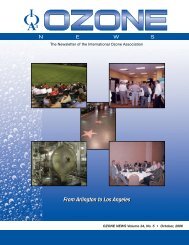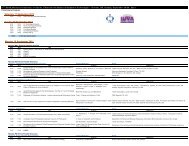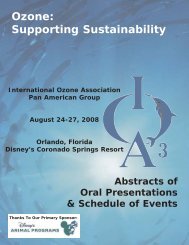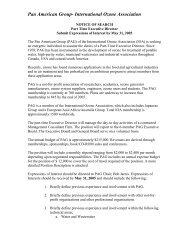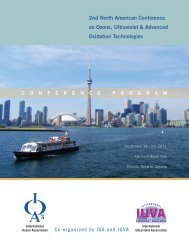Vol 33 No 4 Text - International Ozone Association
Vol 33 No 4 Text - International Ozone Association
Vol 33 No 4 Text - International Ozone Association
Create successful ePaper yourself
Turn your PDF publications into a flip-book with our unique Google optimized e-Paper software.
<strong>Ozone</strong> News <strong>Vol</strong>ume <strong>33</strong>, <strong>No</strong>.4<br />
Industry News(cont’d)<br />
Treatment in the United States”. Currently there are<br />
approximately 204 drinking water plants (>1mgd) using<br />
ozone treating 9,200 mgd water and capable of producing<br />
340,000 lb/day ozone. By 2010, some 240 facilities are<br />
anticipated trating 13,000mgd water and producing<br />
420,000 lb/day ozone. Within the next five years it is<br />
expected that 1/3 of the water treatment capacity will<br />
involve ozone in some form. An ozone use questionnaire<br />
is available for users to input data to update the survey at<br />
http:/kjweb1.kennedyjenks.com/ioasurvey<br />
Kerwin Rakness, Process Applications outlined the<br />
upcoming AWWA <strong>Ozone</strong> Handbook. This handbook is<br />
intended to serve as a practical reference for anyone using<br />
ozone, or planning to use ozone. More details on this<br />
handbook are outlined elsewhere in this issue.<br />
Susan Teefy, Water Quality and Technical Solutions, Inc.<br />
surveyed ozone use in the San Francisco Bay Area.<br />
Robert Hulsey, Black & Veatch outlined the combining of<br />
ozone and UV research into a full-scale design. With UV,<br />
the biggest challenge is how to measure UV effectiveness.<br />
Page 11




